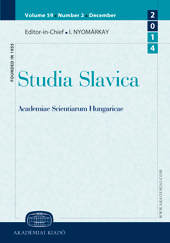Павал Ёзаф Шафарык як беларусіст (На матэрыяле «Гісторыі славянскай мовы і літаратуры ва ўсіх дыялектах» 1826 г.)
Paul Joseph Safarik on Belorusian language (based on the "History of the Slavic languages and literature in all dialects," 1826)
Author(s): Siarhiej ZaprudskiSubject(s): Belarussian Literature, 19th Century, Theory of Literature
Published by: Akadémiai Kiadó
Keywords: Pavel Josef Safarik; Belarusian language; Belarus; Volhynia; Georg Hassel;
Summary/Abstract: This paper deals with “Belarusian” passages of Pavel Josef Safarik’s book The History of the Slavic Language and Literature by All Vernaculars (Buda, 1826) and tries to include them in the context of Belarusian studies in the first third of the 19th century. The set of used and unused sources is assessed, the ways of adoption of information about Belarusian are discussed (Safarik explicitly refers to the works of Adelung, Bandtkie, Rakowiecki, Grech, Kalaidovich). It is ironic that Safarik cites Kalaidovich’s article, in which the term “Belarusian language” was used for the first time as a title of a publication in Ukrainian bibliography. It is stated that Safarik owes Rakowiecki, Kalaidovich and Grech his statements about the history of the Belarusian language. However, when defining the area of Belarusian, he first of all relied on the broad understanding of “Belarus” by geographer Georg Hassel, outlined in his Weimar book Vollständige und neueste Erdbeschreibung des Russischen Reichs in Europa nebst Polen (1821). On the basis of works written by Rakowiecki, Kalaidovich, Grech and Hassel, Safarik defines a wide area of Belarusian (Litva, White Rus’, Black Rus’, Volhynia and Podolia). It is likely that Safarik estimated the size of the population on the territory of Belarus according to Hassel’s work as well.
Journal: Studia Slavica Academiae Scientiarum Hungaricae
- Issue Year: 57/2012
- Issue No: 1
- Page Range: 143-159
- Page Count: 17
- Language: Belarusian
- Content File-PDF

